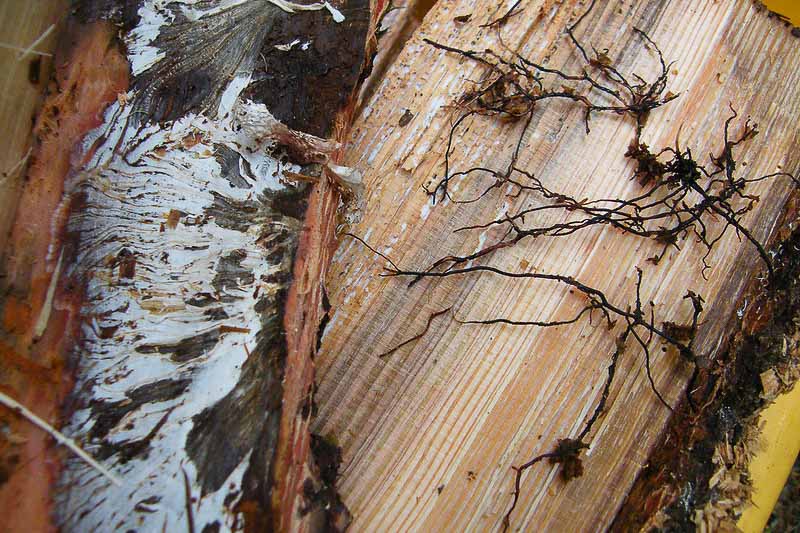Armillaria Root Rot is a destructive fungal disease affecting various trees and woody plants, causing root decay and significant damage to the plant's health and stability
Armillaria Root Rot, also known as oak root fungus or honey fungus, is a prevalent and destructive disease caused by fungi in the genus Armillaria. This disease is known for its ability to attack and kill a wide range of trees and woody plants, both in natural forest settings and landscaped areas.
Armillaria root rot has a broad host range, affecting hundreds of species of trees, shrubs, and woody vines. It also affects palms, succulents, ferns, and other herbaceous plants. Some of its most common hosts include oak, elm, maple, pine, fir, spruce, fruit trees, and many types of ornamental trees and shrubs such as roses or rhododendrons. The susceptibility varies among species, with some being highly susceptible and others having varying degrees of resistance. The only two genera of trees known to be resistant to Armillaria root rot are larch and birch trees.
The disease occurs worldwide, especially in temperate and boreal regions. It is particularly prevalent in North America, Europe, and Asia. Armillaria can survive in a wide range of soil types and climatic conditions, making it a universal threat.
Armillaria root rot is caused by several species of fungi in the genus Armillaria. These fungi survive in the soil and in infected roots, stumps, and lower trunks of trees and shrubs. They spread through the soil via rhizomorphs (root-like structures) and can infect healthy trees through root contact with infected plant material.

Early symptoms of Armillaria root rot often include chlorosis (yellowing of the leaves), reduced growth, wilting, and early leaf drop. The crowns of infected trees may thin, and branches may die back. As the disease progresses, the tree or shrub may die.
One of the most distinguishing features of Armillaria root rot is the presence of honey-colored mushrooms that often sprout from the base of infected trees or shrubs in late summer or fall. Additionally, white, fan-shaped mats of fungal tissue, called mycelial plaques, often form under the bark at the base of infected trees.
The fungi damage trees and shrubs by invading the roots and lower trunk, where they cause decay and disrupt water and nutrient transportation, leading to the death of the plant. The disease can be difficult to diagnose early because below-ground symptoms precede above-ground symptoms. When visible symptoms appear, the fungus may have already caused significant root damage.

Armillaria rhizomorphs, white mycelial fans, and decay
Prevention is the most effective method to manage Armillaria root rot because once plants are infected, control is challenging. The following measures can help prevent and control the disease:
Site Selection and Preparation: Avoid planting susceptible species in areas known to be infected with Armillaria.
Removal of Infected Plants and Roots: Remove and destroy infected plants, including as much of the root system as possible. In some cases, soil fumigation may be used to kill the fungus in the soil.
Use of Resistant or Tolerant Species: Use tree and shrub species known to be resistant or tolerant to Armillaria when planting in infested areas.
Maintaining Plant Health: Keep plants healthy through proper watering, fertilizing, and pest management. Stressed plants are more susceptible to infection.
Avoiding Wounding: Armillaria can infect through wounds, so avoid unnecessary root damage during planting and maintenance.
Fungicides: Unfortunately, fungicides are usually not effective against Armillaria root rot.
Remember that Armillaria root rot is a persistent and challenging disease to control. Therefore, proactive measures are much more effective than trying to save plants after they have become infected.
Create a membership account to save your garden designs and to view them on any device.
Becoming a contributing member of Gardenia is easy and can be done in just a few minutes. If you provide us with your name, email address and the payment of a modest $25 annual membership fee, you will become a full member, enabling you to design and save up to 25 of your garden design ideas.
Join now and start creating your dream garden!
Create a membership account to save your garden designs and to view them on any device.
Becoming a contributing member of Gardenia is easy and can be done in just a few minutes. If you provide us with your name, email address and the payment of a modest $25 annual membership fee, you will become a full member, enabling you to design and save up to 25 of your garden design ideas.
Join now and start creating your dream garden!